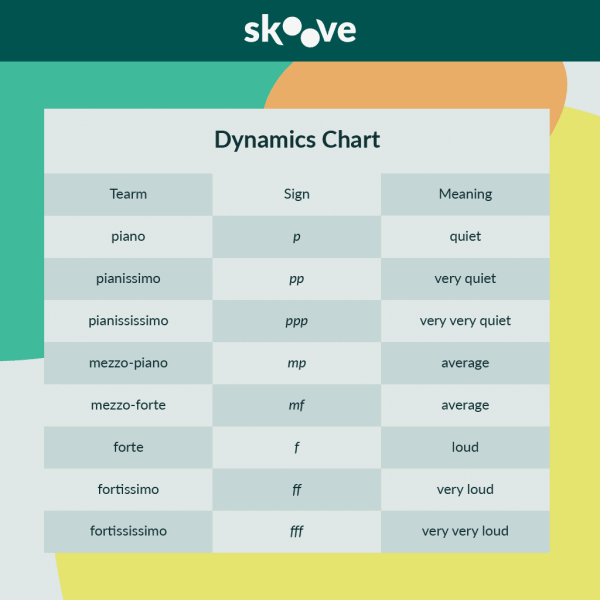Music would be boring and lifeless without dynamics. Dynamics in music give motion, direction, and intention and fill a piece of music with emotion and meaning. Dynamics in music refer to changes in volume, tempo or speed, and feeling.
Dynamics are generally marked with a combination of symbols and words or abbreviations. We often use Italian words for dynamics and musical terms, however you can see dynamic marking written in almost every language.
Let’s explore some of the basic dynamic markings and take a look at some examples of dynamics in sheet music.

What are dynamics in music?
Dynamics are any number of symbols or markings that communicate dynamic changes in a piece of music. However, dynamics are not the same as tempo markings.
Some dynamics, like crescendo, indicate when a section of music should be getting louder. Other dynamics, like diminuendo, indicate when a section should be getting quieter.
Static dynamics
Static dynamic markings are generally used to set the volume level of music. They range from extremely quiet to extremely loud.
We use Italian terms for these dynamics, which is a bit of a remnant of the influences of Italian composers in music. You can learn more about this and other topics with online piano lessons from Skoove!
View this post on Instagram
Piano
Did you know that the original name for the piano instrument was the pianoforte? In music theory, the dynamic of piano (p) means quiet. Anytime you see the dynamic marking piano (p), you should be playing a soft volume and touch.
Mezzo piano
One step up in volume from piano is the dynamic mezzo piano. Mezzo piano means moderately quiet. It is a notation that is used to indicate a volume that is not as quiet as piano, but still not very loud. Its abbreviation is mp.
Mezzo forte
One step above mp is the musical marking mezzo forte (mf). Mezzo forte means moderately loud. It is a medium volume musical marking. You can think of it like a general conversation volume.
It is not exactly quiet, but not exactly loud either.
Forte
Forte (f) means loud and forceful. In music theory, the dynamics of forte are used for passages that should be played loud and strong.
A composer will use this forte loud dynamic for huge sections or during the climactic points in a piece of music.
Pianissimo and fortissimo
There exist some dynamics on the outer edges that composers reserve for more emphasis.
Pianissimo (pp) is a dynamic that means very quiet. Pianissimo is quieter than piano. It is abbreviated pp in music theory.
Fortissimo (ff) means very loud, louder than forte. Fortissimo is used in a piece of music when the composer wants something to blast at at a high volume.
Think of huge, epic brass sections in a symphony or instruments like electric guitar and drums.
Pianississimo and fortississimo
These final two static music dynamics are used for special emphasis on extremely quiet or extremely loud sections.
Pianississimo (ppp) is an extremely soft sound that is abbreviated ppp while fortississimo (fff) is an extremely loud sound that is abbreviated fff. These are the two most dynamics for volume in music theory.
Here is a chart that explains the range of dynamics in music:

Dynamic changes
We can also use dynamic markings to indicate changes in volume levels in a piece of music.
There are a handful of symbols we use for these markings. They all have Italian terms as well.
Crescendo
Crescendo is a dynamic used to mark a section that is getting louder. Crescendo could happen gradually or quickly. The crescendo is abbreviated cresc and looks like this:

The most successful cresc are written with static dynamics for volume on either side so the performers know exactly how much louder to play. Try to practice this example of a crescendo with the online metronome.

Diminuendo or decrescendo
There are two words for the dynamics in music that mean getting quieter: diminuendo or decrescendo.
Like the crescendo, the diminuendo or decrescendo can be written as gradually or rapidly decreasing in volume. It looks like this:

This marking is generally abbreviated as dim or decresc and the most successful markings use static dynamics on either side to describe exactly how softly the performers should play their instruments.

The hairpin
Oftentimes, composers will use a hairpin dynamic to mark a movement in volume.
A hairpin dynamic is an effective strategy to communicate changing dynamics in music. Hairpin dynamics look like this in sheet music notation:

Notice how the composer has placed dynamics piano and forte around the crescendo and diminuendo to indicate how the music notes should be played.
The relative lengths of the markings also describe the speed of the dynamic changes. Longer cresc and dim indicate changes that occur gradually while shorter symbols indicate faster changes from louder to soft volumes.

More Italian terms
There are a handful of other dynamics in music that we use to describe how music should sound and how the instruments should play. Of course, learning Italian is one of the secret benefits of music education.
Staccato and legato
Words like staccato, meaning short and detached, legato, meaning fluid and smooth are necessary to recognize in notation.
Fermata
Symbols like the fermata, which composers will use to indicate when a music note should be held longer, are important to recognize in notation as well so they can be played correctly.
The fermata symbol looks like this above a rest:

Conclusion
Dynamics are extremely important musical markings. They describe how music should be played and at what volumes. Some dynamics instruct us to play loudly while other dynamics instruct us to play softer.
Next time you listen to some instruments, check out how quietly they play. Where is the emphasis? Which instrument is playing the phrase softly? When you look at an example of musical notation, be sure to pay attention to the musical markings there as well!
And of course, Skoove can help you to become a more musical pianist at any stage of your journey! With over 400 interactive lessons ranging from exciting pop and classical repertoire, to ideas about theory and technique, you are sure to find some notes that resonate with you!
Author of this blog post:

Eddie Bond is a multi-instrumentalist performer, composer, and music instructor currently based in Seattle, Washington USA. He has performed extensively in the US, Canada, Argentina, and China, released over 40 albums, and has over a decade experience working with music students of all ages and ability levels.















